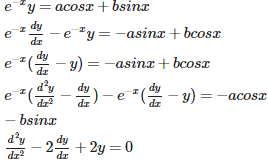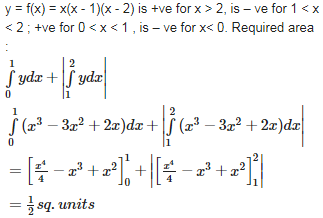CBSE 12TH MATHEMATICS - Online Test
Q1. The relation is valid for
Answer : Option C
Explaination / Solution:
The relation is true for all real values of x greater than or equal to 1.
Q2.
is equal to
Answer : Option D
Explaination / Solution:
Q4. Determine whether the given planes are parallel or perpendicular, and in case they are neither, find the angles between them.7x + 5y + 6z + 30 = 0 and 3x – y – 10z + 4 = 0
Answer : Option D
Explaination / Solution:


Q5. Forming a differential equation representing the given family of curves by eliminating arbitrary constants a and b from y = (a cosx + b sinx) yields the differential equation
Answer : Option D
Explaination / Solution:


Q6. There are two types of fertilizers F1 and F2. F1 consists of 10% nitrogen and 6% phosphoric acid and F2 consists of 5% nitrogen and 10% phosphoric acid. After testing the soil conditions, a farmer finds that she needs atleast 14 kg of nitrogen and 14 kg of phosphoric acid for her crop. If F1 costs Rs 6/kg and F2 costsRs 5/kg, determine how much of each type of fertiliser should be used so that nutrient requirements are met at a minimum cost. What is the minimum cost?
Answer : Option C
Explaination / Solution:
Let number of kgs. of fertilizer F1 = x
And number of kgs. of fertilizer F2 = y
Therefore , the above L.P.P. is given as :
Minimise , Z = 6x +5y , subject to the constraints : 10/100 x + 5/100y ≥ 14 and 6/100x + 10/100y ≥ 14, i.e. 2 x + y ≥ 280 and 3x + 5y ≥ 700, x,y ≥ 0.,
Corner points | Z =6x +5 y |
A ( 0 , 280 ) | 1400 |
D(700/3,0 ) | 1400 |
B(100,80) | 1000………….(Min.) |
Corner points Z =6x +5 y A ( 0 , 280 ) 1400 D(700/3,0 ) 1400 B(100,80) 1000………….(Min.) Here Z = 1000 is minimum.
i.e. 100 kg of fertilizer F1 and 80 kg of fertilizer F2; Minimum cost = Rs 1000.
Q7. Find the slope of the normal to the curve at
Answer : Option B
Explaination / Solution:


Q8. Let A = {1, 2, 3} and B = {2, 3, 4}, then which of the following is a function from A to B?
Answer : Option B
Explaination / Solution:
{(1, 3), (2, 3), (3, 3)} is a function ,because for each x ∈ A , there is a unique y ∈ B such that ( x , y) ∈f., i.e. xfy.
Q9. Find the area of triangle with vertices ( 1 ,1 ) , (2 ,2 ) and ( 3, 3 ).
Answer : Option C
Explaination / Solution:
AREA OF TRIANGLE= 

That is C1 and C2 are identical
so value of determinant =0
hence area of triangle =0
Q10. The area bounded by the curve y = x (x – 1 ) ( x – 2 ) and the x – axis is equal to
Answer : Option D
Explaination / Solution:




